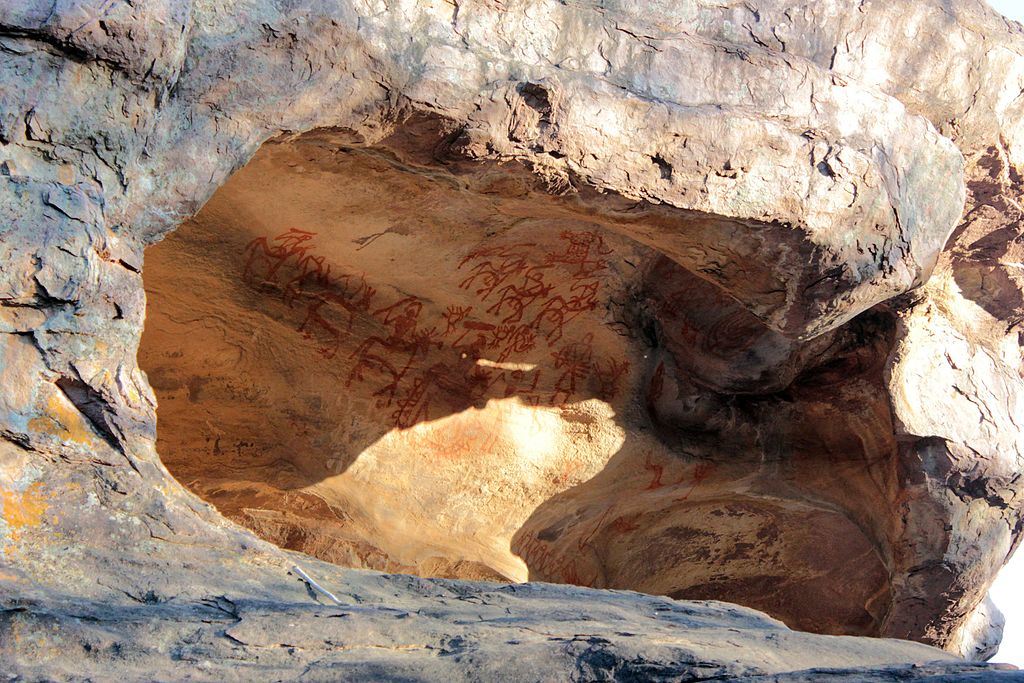

Its plan resembles a "right-angled cross" with four of its branches aligned to the four cardinal directions.

Robert Bednarik describes the prehistoric Auditorium cave as one with a "cathedral-like" atmosphere, with "its Gothic arches and soaring spaces". Surrounded by quartzite towers which are visible from several kilometres' distance, the Auditorium rock is the largest shelter at Bhimbetka. Of the numerous shelters, the Auditorium cave is one of the significant features of the site. It was declared as a world heritage site by UNESCO in 2003. The site consisting of 1,892 hectares was declared as protected under Indian laws and came under the management of the Archaeological Survey of India in 1990. īarkheda has been identified as the source of the raw materials used in some of the monoliths discovered at Bhimbetka. The site contains the world's oldest stone walls and floors. This is based on excavations at the site, the discovered artifacts and wares, pigments in deposits, as well as the rock paintings. According to Archaeological Survey of India, the evidence suggests that there has been a continuous human settlement here from the Stone Age through the late Acheulian to the late Mesolithic until the 2nd century BCE in these caves. The Bhimbetka group contains 243 of these, while the Lakha Juar group nearby has 178 shelters. Since then, more than 750 rock shelters have been identified. It was only in the 1970s that the scale and true significance of the Bhimbetka rock shelters was discovered and reported. He visited the area with a team of archaeologists and reported several prehistoric rock shelters in 1957. Wakankar, who saw these rock formations and thought these were similar to those he had seen in Spain and France.

The first archaeologist to visit a few caves at the site and discover its prehistoric significance was V. He relied on the information he gathered from local adivasis (tribals) about Bhojpur lake in the area and referred to Bhimbetka as a Buddhist site. Kincaid, a British India era official, first mentioned Bhimbetka in a scholarly paper in 1888. One of about 750 rock shelter caves at Bhimbetka. ĥ50 million years old Dickinsonia fossils of extinct genus of basal animals has been found at Bhimbetka. Of the 750 rock shelters, only 12 to 15 are open to visitors. īhimbetka rock art is considered oldest petroglyphs in the world, some of these similar to aboriginal rock art in Australia and the paleolithic Lascaux cave paintings in France. The Bhimbetka site has the oldest-known rock art in India, as well as is one of the largest prehistoric complexes. These cave paintings show themes such as animals, early evidence of dance and hunting. 8,000 BCE), corresponding to the Indian Mesolithic. Some of the Bhimbetka rock shelters feature prehistoric cave paintings and the earliest are about 10,000 years old (c. The rock shelters and caves provide evidence of, according to Encyclopædia Britannica, a "rare glimpse" into human settlement and cultural evolution from hunter-gatherers, to agriculture, and expressions of prehistoric spirituality. At least some of the shelters were inhabited more than 100,000 years ago. It is a UNESCO World Heritage Site that consists of seven hills and over 750 rock shelters distributed over 10 km (6.2 mi). It is located in the Raisen District in the Indian state of Madhya Pradesh about 45 kilometres (28 mi) south-east of Bhopal.

It exhibits the earliest traces of human life in India and evidence of Stone Age starting at the site in Acheulian times. The Bhimbetka rock shelters are an archaeological site in central India that spans the Paleolithic and Mesolithic periods, as well as the historic period. Bhimbetka rock shelters (Madhya Pradesh) Show map of Madhya Pradesh


 0 kommentar(er)
0 kommentar(er)
